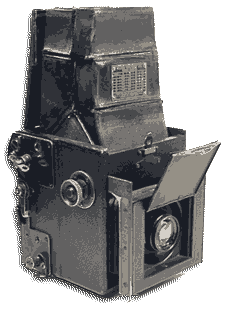
Film type: Sheet Film (2x3 inches)
Approx. dates of manufacture: 1914 - 1924
Approx. original price: $35 (body only)
Approx. street value: moderate
William Folmer was a bicyle maker when he got interested in photography; and being an inventor, he saw ways to make improvements. Through most of the 19th century, light-sensitive materials (which I'll call film for simplicity here) were not very light sensitive, so exposures were measured in seconds and minutes, and could be done by simply taking the lens cap off for the required time and then putting it back on. But as film became more sensitive, photographers needed a way of making faster exposures. Folmer's idea was a mechanically moving curtain that was located right next to the film in the back of the camera, and it became known as the focal-plane shutter. Many of the best film cameras still use focal-plane shutter.
One of the neat things about the focal-plane shutter was that when it was closed and the film protected, light still streamed through the lens. So if you put a mirror between the lens and the shutter, you could see the image that the lens created. Put the mirror on a hinge and add a lever, and the image could be composed with the mirror in position, then flipped out of the way. Then the focal-plane shutter was tripped, the film exposed, and photograph made. Simply reset the shutter and drop the mirror back into position.
Cameras with mirrors became known as reflex cameras. If the camera only had one lens, it was known as a single-lens reflex (SLR) camera. If the camera had two lenses (one for taking the image, and the other for composition), it was a twin-lens reflex (TLR). TLRs would become popular in the mid-20th century with the advent of the Rolleiflex.
When Folmer and his partner William Schwing began making cameras, they called them Graphics. So a Graphic Reflex became the Graflex, their most famous line of cameras. It was such a name that it would eventually become the name of the company itself, and other reflex cameras would blur their names onto their cameras: Rollei made the Rolleiflex, Canon made a Canonflex, and the famous Nikon F was supposedly named as being a shorthand for Nikonflex.
So back to the subject. Over the years, Folmer & Schwing mostly made two kinds of cameras, Graphics and Graflexes, and made them in various sizes and configurations. This particular one, the Junior, got its name for being small. The standard-sized Graflex took 4x5-inch sheet film or plates, but this guy took 2x3-inch. Still big enough to make decent sized enlagements, and small and light enough to take around town with you. It collapses into a nice little box, but a couple button presses and the viewing hood pops up the top and the lens out the front.
Mine is pretty beat up; another online auction buy. The hood and the lens cover have to be coaxed open, and if I were to actually use it I'd have to clean the optics. But it's complete, the shutter groans but still works, and it's a nice bookend with my Speed Graphic.
Camera manual: Orphan Cameras.com


